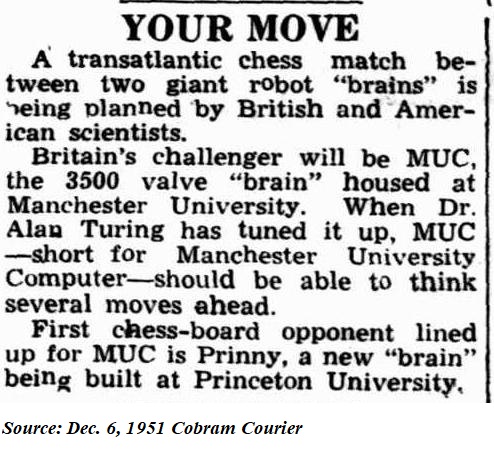© Mark Ollig
British mathematician and cryptologist Alan Turing broke the encryption coding method created by Enigma machines the German military used to transmit secret messages during World War II.
Turing worked with three other senior code-breakers within a top-secret intelligence group known as Ultra.
Together, they built a cabinet-sized electromechanical device “bombe” or code-cracking machine.
Fully operational in 1942, Turing’s decrypting machine decoded nearly 39,000 messages per month containing German military communications within hours of their being transmitted.
Japanese military messages were also decoded.
It is stated Ultra greatly assisted in bringing an end to WWII.
“It was thanks to Ultra that we won the war,” British Prime Minister Winston Churchill reportedly said.
Western Supreme Allied Commander Dwight D. Eisenhowever disclosed in a 1965 interview that Ultra was “decisive” in winning the war.
Turing was made an Officer of the Most Excellent Order of the British Empire for his code-breaking work.
In 1948, Turing authored a paper titled “Intelligent Machinery.”
In this paper, Turing explained how to design a “thinking machine,” by building a robot that would mimic a human and “roam the countryside” to educate itself.
He was describing how to design artificial intelligence in a machine that could learn from its own experiences.
In the late 1940s, Turing, along with David Champernowne, studied mathematics at King’s College, Cambridge, UK.
In 1948, while researching machine learning, Turing and Champernowne developed a chess program capable of playing against a human, to demonstrate how a machine could think.
They named this chess program Turochamp, a combination of Turing and Champernowne.
Turing received most of the credit for this chess-playing algorithmic program, whose lines of code were written using a pencil and paper.
Turochamp could “think” two moves in advance, using logical searching decision trees to make the best chess moves.
“Our general conclusion was that a computer should be fairly easy to program to play a game of chess against a beginner, and stand a fair chance of winning or least reaching a winning position,” Champernowne was quoted as saying years later.
When the Turochamp program was written, the type of computer needed to fully execute it did not yet exist.
In 1950, Turing authored the essay, “Computing Machinery and Intelligence,” in which he proposed the question: “Can machines think?”
Turing said this question needed to be asked, due to the development of electronic and digital computers.
He went on to cite examples of deductive reasoning from which a machine could come to logical conclusions.
During 1950, Turing had begun coding the Turochamp program into a Ferranti Mark 1 computer, also known as the Manchester University Computer (MUC).
A Dec. 6, 1951 article in the Cobram Courier, an Australian newspaper, said, “A transatlantic chess match between two giant robot “brains” is being planned. When Dr. Alan Turing has tuned it up, MUC should be able to think several moves ahead.”
The transatlantic computer chess opponent was to be an American computer nicknamed Prinny, built at Princeton University in New Jersey, where Turing spent two academic years, from 1936 to 1938.
Unfortunately, the coded instruction transfers of Turochamp’s algorithms into the MUC had not been finished at the time of Turing’s death in 1954.
During the June 23, 2012 celebration of Turing’s 100th birthday observance at the Alan Turing Centenary Conference in Manchester, UK, the 1948 computer chess program, Turochamp, was loaded into a modern-day computer.
Chess grandmaster Garry Kasparov agreed to play against Turochamp.
This columnist enjoys a competitive chess game every now and then. So, I was very interested in seeing how the logical chess-playing computations created in 1948 would fare in a match against a champion chess player like Kasparov.
Kasparov appeared eager to play the program, as he quickly sat down at the table to begin the chess game.
A large screen displayed to the audience the chess game moves as they occurred in real-time.
Turochamp opened the game playing the white chess pieces with the queen’s pawn, or e3 chess opening.
Turing’s chess program was playing very well; until Kasparov took control of the game.
Kasparov swiftly moved his chess pieces in a precise, calculating manner. He took only seconds in-between moves and methodically overpowered Turochamp’s defenses.
“I’m sorry!” Kasparov smilingly said while capturing the white chess pieces.
He then quickly closed in for the win with his queen and knight, checkmating Turochamp’s king in only 16 moves.
Kasparov is known for calculating chess game scenarios 10 moves in advance, and so the win was not unexpected.
After the game, Kasparov complimented Turing and Champernowne’s chess program by saying, “Although it’s only thinking two moves ahead, I thought it would give the amateur player some serious problems.”
Kasparov went on to say, “It was an outstanding accomplishment. Alan Turing is one of the very few people about who you could say that if he had lived longer, the world would be a different place.”
Alan Mathison Turing died June 7, 1954, at age 41.
David Gawen Champernowne passed away Aug. 19, 2000, at the age of 88.
Watch the video of Garry Kasparov playing against the Turochamp chess program at https://tinyurl.com/ycfmzans.
Stay safe out there.







